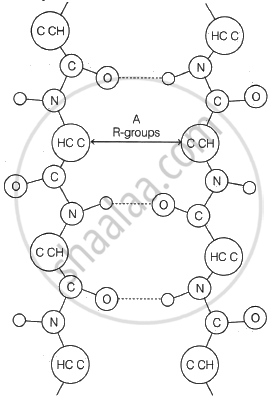Advertisements
Advertisements
प्रश्न
Explain the classification of carbohydrates with examples.
उत्तर
Classification of carbohydrates: Carbohydrates are classified into three broad groups in accordance with their behaviour on hydrolysis as monosaccharides, oligosaccharides, and polysaccharides.
- Monosaccharides: Monosaccharides are carbohydrates which do not hydrolyse further into smaller units of polyhydroxy aldehydes or ketones.
e.g. Glucose, fructose, ribose - Oligosaccharides: Oligosaccharides are carbohydrates which on hydrolysis yield two to ten units of monosaccharides and accordingly they are further classified as disaccharides, trisaccharides, and so on.
a. Disaccharides yield two monosaccharide units on hydrolysis.
e.g. Sucrose
b. Trisaccharides yield three monosaccharide units on hydrolysis.
e.g. Raffinose
c. Tetrasaccharides yield four monosaccharide units on hydrolysis.
e.g. Stachyose - Polysaccharides: Polysaccharides give very large number of monosaccharide units on complete hydrolysis.
e.g. Starch, glycogen, cellulose
संबंधित प्रश्न
Give scientific reasons:
The disaccharide sucrose gives negative Tollens test while the disaccharide maltose gives a positive Tollens test.
Write a commercial method for preparation of glucose.
Formation of lactose by conden ation results in the release of how many molecules of water?
The reserve food material in animals is ____________.
From the following identify the materials that are made up of cellulose.
i. Plant cell wall
ii. Exoskeleton of arthropods
iii. Paper from plant pulp
iv. Cotton fibre
Match the Column I and Column II select the correct option.
| Column I | Column II | ||
| i. | Monosaccharides | a. | Stored energy in animals |
| ii. | Glycogen | b. | Polymer made from ß-glucose molecules |
| iii. | Cellulose | c. | Exoskeleton of arthropods |
| iv. | Chitin | d. | Building blocks of carbohydrates |
| e. | Plant hormone |
____________ do not give smaller sugar units on hydrolysis.
Monosaccharides are ______ in nature.
Which carbon atoms of α- D glucopyranose and β-D-fructofuranose respectively are linked together to form glycosidic linkage in sucrose?
Prolonged heating of glucose with hot HI results in the formation of ____________.
Which element among the following is not present in saccharine?
Which one of the following is an oligosaccharide?
Identify the number of secondary carbon atoms in glucose.
What is the molecular formula of glyceraldehyde?
What is the product obtained when Br2 water reacts with glucose?
Which among the following observations suggests that glucose also exists in cyclic form?
Which one of the following rotates the plane polarized light towards left?
The number of sp2 and sp3 hybridised carbon in fructose are respectively ____________.
α-D (+) Glucose and β-D (+) glucose are ____________.
What are reducing and non-reducing sugars?
Lactose is made of ______.
The two monosaccharides in a disaccharide are held together by ______ bonds.

Formation of gluconic acid from glucose by oxidation using Br2 water.
Carbohydrates that do not undergo hydrolysis further are called ______.
Why carbohydrates are generally optically active.
The linkage present in Lactose is ______.
CH2 OH - CO - (CHOH)4 - CH2 OH is an example of ______.
Why carbohydrates are generally optically active?
